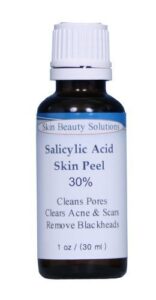Doing a chemical peel may seem like a more terrifying experience then it really is especially when you think about the vision that is the (now cliché) red-faced character of Samantha from the classic tv show Sex And The City. Turns out, when done right chemical peels help target aging concerns like uneven skin tone, acne scars, and fine lines as well as wrinkles. Although lasers may have become the current go-to treatment for these types of concerns, certain types of chemical peels can also be effective while being easier on the wallet and also less invasive.
WHAT DO CHEMICAL PEELS DO?
By removing the Stratum Corneum, the top layer of the Epidermis which is compromised (for the most part) of dead cells, chemical peels provide a deep level of exfoliation revealing the fresh layers of skin underneath. When you combine the fact that this layer thickens as we grow older due to the slow down of the rate that our body’s regenerative processes work at with environmental damage from factors like UV rays, pollution as well as our hormones you’re left with dull skin that may actually look older than it really is.
THREE LEVELS OF CHEMICAL PEELS
Chemical peels can be divided into three main strength categories: Light (or superficial), medium, and deep. Deciding on which level of chemical peel you’d like to do is based on your experience with them, the desired results you’re looking to achieve and the types of aging concerns you’re looking to target.
LIGHT TO LIGHT-MEDIUM CHEMICAL PEELS
Light or superficial chemical peels are used to treat fine lines, areas of dryness, uneven pigmentation, and acne. Often coined lunchtime peels, these treatments are ideal for people who want the benefits of facial peeling but do not wish to have a long recovery period. AHA (Alpha Hydroxy Acids) peels like Glycolic, Lactic and Mandelic as well as BHA (Beta Hydroxy Acid) peels like Salicylic Acid are the most common.
GLYCOLIC ACID PEELS
Glycolic acid chemical peels are considered to be some of the most popular types for rejuvenation out there. These kinds of chemical peels are generally suitable for most skin types except those that are particularly sensitive or have conditions like rosacea. Depending on the strength, these type of chemical peels will help boost collagen production as well as reduce the appearance of fine lines, acne scars, and skin discolorations.
Glycolic Acid chemical peels are commonly found in strengths that range from 20-70% but it’s advised to leave peels above 60% in the hands of a trusted skin-care practitioner. Glycolic Acid peels that are in the range of 20-30% are best for beginner and will provide mild exfoliation while the 40-50% strengths go deeper and are able to target signs of aging like lines as well as acne scars.
RECOMMENDED PRODUCT

Skin Obsessions 30% Glycolic Acid Peel ($13.99)
Skin Obsessions’ Glycolic Acid Peel is medical grade and has a pH of 2 ensuring that it will penetrate the skin correctly. The formula is housed in an Amber glass bottle to protect the ingredients from air and light degradation. The brand also has Glycolic Acid peels in a 40% solution ($16.99) and 50% solution ($20.99) allowing for customization based on your skin’s needs.
LACTIC ACID PEELS
Lactic acid is derived from milk and is considered to be one of the more gentle types of chemical peels out there. Though these types of chemical peels may help reduce aging concerns like fine lines, they are mainly known for their brightening and hydrating properties, making them especially suitable for those with dry and sensitive skin types. Peels in the range of 25-40% strengths are recommended for those interested in home peeling, with 25% being a good starting point for a first time peeler.
RECOMMENDED PRODUCT
 Makeup Artist’s Choice 40% Lactic acid peel ($17.75)
Makeup Artist’s Choice 40% Lactic acid peel ($17.75)
Makeup Artist’s Choice non-irritating formula combines Lactic Acid with Licorice Extract to maximize the brightening benefits. The chemical peel solution is perfect for those with sensitive skin and gently exfoliates skin without causing any noticeable flaking.
MANDELIC ACID PEELS
Derived from bitter almonds, Mandelic Acid is considered to be among the most gentle types of chemical peels as its molecules are on the larger side so it takes them longer to penetrate the skin. Due to Mandelic Acid’s antibacterial properties, this type of peel is great for those with acne-prone skin who are allergic to aspirin and therefore have an increased chance of reacting to Salicylic Acid. These kinds of chemical peels are popular in 25-40% strengths and mainly help with acne marks and other forms of hyperpigmentation like age spots.
RECOMMENDED PRODUCT
Makeup Artist’s Choice 25% Mandelic Acid Peel ($17.95)
Makeup Artist’s Choice 25% Mandelic Acid peel helps refine uneven skin tone and boost overall clarity. Other benefits of using this chemical peel include that it will help reduce blackheads and clean up enlarged pores. The formula also includes Green Tea Extract in order to sooth and fight against free radical damage.
SALICYLIC ACID PEELS
Closely related to Aspirin (acetylsalicylic acid), Salicylic Acid peels are known for their anti-inflammatory properties and works well to combat oiliness, clogged pores, skin prone to breakouts, and in some cases are even suitable for sensitive skin as well as conditions like Rosacea. It should be noted if you’re allergic to Aspirin to prevent the chance of a negative reaction consider avoiding a Salicylic Acid chemical peel.
In terms of strength, 10-20% is great for those that have dry or sensitive skin who may also suffer from breakouts. While 30-40% strengths work well for those with oilier skin prone to acne and clogged pores. Finally, the 40-50% strengths are beneficial for those who need a more aggressive level of peeling.
RECOMMENDED PRODUCT
Skin Beauty Solutions 30% Salicylic Acid peel ($19.99)
Skin Beauty Solutions’ Salicylic Acid Peel formula is cosmetic grade and made without filler, fragrances and even unnecessary preservatives. If you’re new peeling with Salicylic Acid it’s recommended to start with the 20% solution ($18).
LIGHT TO MEDIUM CHEMICAL PEEL SIDE EFFECTS
In most cases, side effects for light-medium peels are quite minimal and require little to no downtime, allowing an immediate return to regular activities and work. Skin may appear slightly red and irritated for the first few hours after the peel and flake lightly over the next few days.
LIGHT TO MEDIUM CHEMICAL PEEL RESULTS
A series of about 5-8 peels spread anywhere from 2-4 weeks apart are recommended to achieve maximum results. Regular chemical peels every 1-2 months after the initial set of treatments are needed to maintain results.
MEDIUM PEELS (TCA PEELS)
Trichloroacetic Acid (TCA) peels are effective in achieving more advanced results than their lighter counterparts and target aging concerns inclusive of wrinkles and uneven skin tone in general. It should be noted that these types of chemical peels have an extended recovery time that ranges from 7-14 days so make sure to prepare accordingly. TCA peels work well for all skin tones including darker ones and also make good spot treatments when dealing with targeted skin concerns like freckles or hyperpigmentation.
RECOMMENDED PRODUCT
Perfect Image 25% TCA Peel ($22.49)
Through the combination of 5% Salicylic Acid, 25% Trichloroacetic Acid and soothing plant extracts from the like of Cucumber, Chamomile and Green Tea this chemical peel provides advanced results while minimizing irritation. The formula is also free of parabens, sulfates, and phthalates as well as cruelty-free. If you’re new to TCA peels consider trying the popular 15% chemical solution ( $29.95) to start with.
SIDE EFFECTS
Although at 25-35% strengths TCA chemical peels can be considered a safer option when trying to avoid the risk of scarring that higher percentage concentrations are associated with there are still some side effects that one should be aware of inclusive of hyperpigmentation, sun sensitivity and post peel break-outs.
TCA PEEL RESULTS
Depending on the condition of skin and desired results, 1-3 peels split up by 4-6 week intervals is a good estimate for the initial set of treatments needed. Results can last up to 6 months, at which time a maintenance peel or two may be needed.
RECOVERING FROM MEDIUM PEELS
Unlike some of their lighter counterparts TCA Peels will actually cause visibly peeling and though it’s possible to go back to normal activity, post-treatment may require some downtime (generally up to a week) since it can look quite scary. After the treatment, there might be some mild swelling and discomfort. For the first 1-3 days, skin will darken and a superficial crust will form. Within 3-7 days this crust will generally flake off. The new skin may appear reddish but it will fully fade within 7-10 days to reveal the results. In total, it will be about 7-10 days before you’d want to be seen in public and approximately two weeks before your skin looks completely normal. Skin will be pretty delicate so aftercare is extremely important.
WHY AVOID DEEP PEELS
With a deep chemical peel, like the Phenol Peel, the risks often outweigh the benefits. A similar level of results can be achieved through alternative anti-aging treatments like lasers that when done right not only avoid the extended recovery period associated with deeper peels but minimize the chances of advanced pigmentation issues and permanent scarring.
Be sure to check out our guide if you’re interested in learning more about the anti-aging benefits of lasers.
WHAT HAPPENS DURING A CHEMICAL PEEL?
Below are some general guidelines of what to expect during a standard chemical peel process:
- Skin is washed with a gentle cleanser and sometimes alcohol is used in order to remove all surface oil.
- A thin layer of a chemical peel solution is applied, with gauze, cotton or a fan brush to the entire surface being treated. Sometimes a burning, itching, tingling feeling may be experienced at this point. In order to counter this, the use of a fan may help.
- After the recommended time for being on the skin has passed, skin is neutralized with either cold water or a special neutralizing agent (often times baking soda combined with water) depending on the kind of peel. Make sure to gently wipe a few times to ensure the solution is fully removed, or if doing the peel at home, make sure to close your eyes and rinse your skin a couple of times with cold water.
- Finally, a moisturizer followed by a sunscreen (if treatment is done in the day) should be applied to protect the skin.
When the peeling solution is on the skin, make sure to describe any uncomfortable feeling to the skin care practitioner doing the peel. If doing it at home, carefully observe the areas where the chemical peel solution is applied to see if they are getting too red or if they are painful. If certain areas do feel uncomfortable, apply a cloth or cotton pad that is soaked in the neutralizing solution or water to that area.
THE BRUSH THAT MAKES A DIFFERENCE
Taklon Fan Brush ($6.93)
Reduce wastage of your chemical peel solution by investing in this sturdy fan brush that allows an even application while avoiding the absorption that happens with cotton balls or pads.
THINGS TO NOTE WHEN DOING A CHEMICAL PEEL AT HOME
Although at home chemical peels can be a cost-effective alternative to doing them at a professional’s office it’s important to be careful. Make sure to use good common sense, follow instructions, and heed safety precautions.
- Consider getting a few peels done by a professional to understand the process before trying it at home. This is especially important when it comes to deeper peels like TCA.
- Don’t overestimate your skin’s strength, 30-50% AHA or BHA and 25% and below TCA peels work well for most people at home. If you’re unsure, start with a lower strength first and work your way up in time.
- Make sure to do a spot test at least 24 hours ahead of when you want to do your chemical peel. Apply a small amount of the acid solution on a patch of skin that isn’t prominent and follows the removal instructions. If your skin as a severe reaction it might be best to avoid going forward with the chemical peel.
- More advanced results are built over a series of peels and you should be in no rush to constantly peel (every 4-8 weeks is a reasonable estimate). Also, respect the peel instructions, especially regarding how long to leave it on (as you peel more you can keep it on longer). Overdoing is just not worth the risk and may result in severely irritated and damaged skin.
- Research the peel’s pH – the lower the pH the more acidic it is, which affects strength. For anti-aging, a pH below 4 is recommended to be effective with a pH of 2-4 being a good range to look for.
- Generally, we recommend unbuffered formulas, meaning the pH has not been altered, increased, or decreased.
Please note – we are not licensed medical professionals and are not liable or responsible for any advice or course of treatment you should take. We recommend that you talk to a medical practitioner before proceeding with a chemical peel at home.
HOW TO PREPARE YOUR SKIN FOR A CHEMICAL PEEL?
Consider using products that help break down patches of thick skin to ensure that the chemical peel solution you’re using penetrates evenly and provides your skin with the maximum level of benefits that it’s supposed to.
For this purpose experts recommend the use of a Retinoid, a derivative of Vitamin A, available through prescription in the form of Retin-A or over the counter as Retinol. Although those with more experience with chemical peels don’t need to prep as long, if it’s your first time, you might need to apply your retinoid of choice for up to a month or longer. If your skin is too sensitive for retinoids, a milder AHA cream or serum will also work.
BEFORE & AFTER TREATMENT
Below are some general guidelines to consider before and after a chemical peel treatment:
HAIR REMOVAL
Pre Peel: 1 week before the peel avoid forms of hair removal including waxing and depilatory creams (Nair).
Post Peel: Generally wait 12-14 days after skin heals before starting up with hair removal again.
AT HOME DEVICES, LOTIONS & POTIONS
Pre Peel: 3-7 days before peeling stop using cleansing brush devices, as well as topical products that contain AHA (Glycolic & Lactic acid), BHA (Salicylic Acid), Retinoids (including Retin-A, Differin, and Tazorac, Retinol) and Benzoyl Peroxide.
Post Peel: Wait about 7-10 days to start using these products again.
EXERCISE
Post Peel: For the first 24-48 hours post-treatment, most experts recommend avoiding swimming as both chlorine and salt water will dry out and irritate your skin. Depending on the depth of your peel consider avoiding the gym anywhere from 8 hours for light intensity workouts to 24-48 hours for ones where you sweat more profusely. Again depending on the depth of the peel try and also avoid the sauna for 2-4 weeks post peel, as the intense heat can lead to pigmentation issues on healing skin.
IMPORTANT THINGS TO NOTE
- If you’re allergic to Aspirin, avoid Salicylic acid peels in order to minimize the chance of a negative reaction.
- Let tans fade pre-peel and generally wait 6 weeks before heading to extreme conditions (very cold or very hot weather) as they can affect the skin’s pigmentation.
- Avoid anti-aging treatments (like IPL and laser treatment) before or after a chemical peel for about 1-4 weeks until skin sensitivity has completely gone.
- Antibiotics, Accutane as well as other medicines that cause sun sensitivity should be completely out of the system before proceeding with a chemical peel.
- Avoid peels on areas that have open sores, wounds, sunburns, or are excessively sensitive.
POST PEEL CARE
GENTLENESS IS KEY
After the first time cleaning your skin post-peel refrain from doing it again for the next 6-8 hours to avoid irritation.
Consider investing in a gentle cleanser like Cetaphil ($19.82) and a moisturizer like First Aid Beauty’s Ultra Repair Face Moisturizer ($24) that should be used twice a day, until your skin has healed (about 1 week for superficial peels and 2 weeks for medium ones).
It’s important to note, especially during the first few days of recovery when your skin is at its most delicate to avoid rubbing instead gently dry it by tapping.
If you have areas of skin that are severely irritated try applying Aquaphor ($12.82) until they are fully recovered.
Be sure to read our in-depth overview if you’re interested in exploring some of the best anti-aging cleansers.
MEET YOUR NEW BEST FRIEND, SUN PROTECTION
By exfoliating the top layers of your skin, it’s more sensitive to the sun and vulnerable to UV damage, especially for the first 2-4 weeks post-treatment. When out and about, embrace wearing a hat (preferably a wide-brimmed one) as well as dark sunglasses. Most importantly, use a broad spectrum sunscreen religiously.
Explore our guide to learn more about how to pick a good sunscreen, inclusive of ingredients to look out for as well as best practices.
YOU MAY PEEL A LOT OR NOT
With lighter peels, although skin may still be tight and a little dry, you might not see any visible peeling but this doesn’t mean you won’t experience results. With medium level peels, try and schedule them when you can take a few days off (like over a long weekend) as chances are you will peel a lot especially during the first few days. In any case make sure not to pick peeling skin, even when it is really annoying as it can lead to hyperpigmentation, infection, and in some cases permanent scarring.
FINAL THOUGHTS
Although chemical peels work best in a series, addiction is an easy trap to fall into so always keep in mind the less is more approach. Over-peeled skin can look waxy and thin and can actually accelerate the signs of aging, leading to permanent damage such as fine lines and wrinkles as well as an increased vulnerability to UV radiation.







